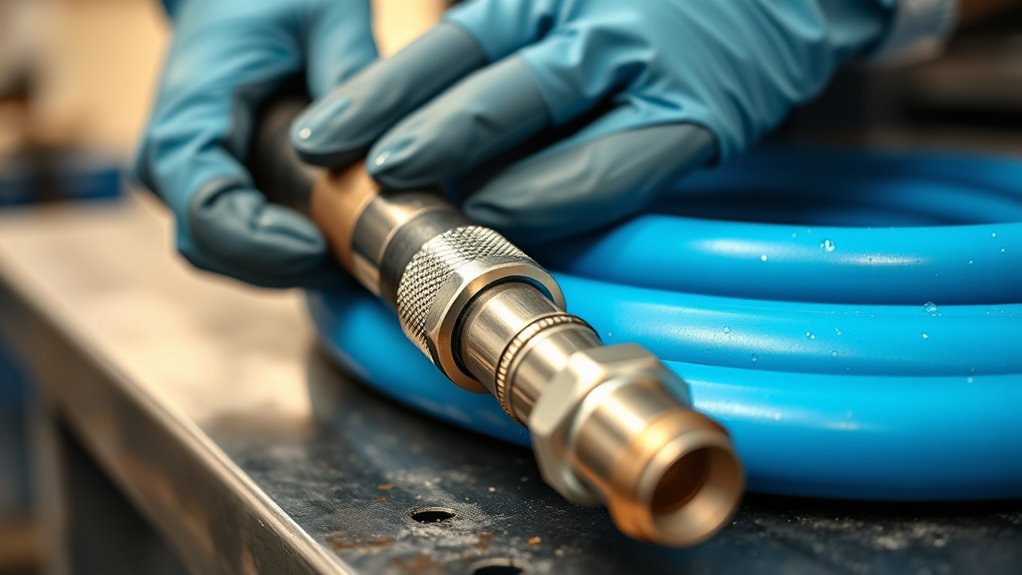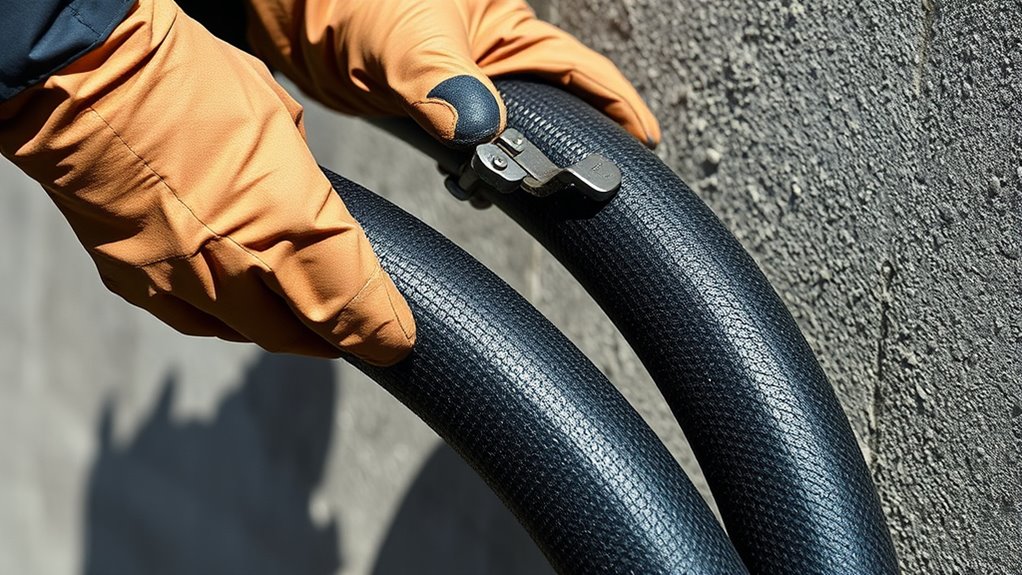To extend your water jet hose life, regularly inspect for cracks, leaks, and wear signs, replacing damaged hoses promptly. Maintain proper water pressure using regulators to prevent stress and bursting. Clean hoses and fittings often to remove mineral deposits and debris, ensuring smooth water flow. Store hoses properly by draining and keeping them in a cool, dry place away from sunlight. Following these steps can greatly improve durability — discover more tips to keep your system running smoothly.
Key Takeaways
- Regularly inspect hoses for cracks, leaks, and wear to catch damage early.
- Maintain proper water pressure with regulators to prevent hose bursts and degradation.
- Clean hoses and fittings periodically to remove mineral deposits and debris buildup.
- Drain and store hoses in cool, dry environments to prevent freezing and environmental damage.
- Conduct routine maintenance to extend hose lifespan, ensure system reliability, and optimize performance.

Maintaining your water jet system is crucial to guarantee it performs at its best and lasts longer. One of the most critical aspects of upkeep is regular hose inspection. Over time, hoses can develop cracks, leaks, or signs of wear that might not be immediately obvious. By routinely checking the hose for any visible damage, you can catch problems early and prevent more serious issues down the line. Look for any soft spots, bulges, or signs of degradation in the material. If you notice any damage, replace the hose promptly to avoid water loss or sudden failure during operation. Additionally, inspect the fittings and connections to ensure they’re secure and free of corrosion. Proper hose maintenance not only extends its lifespan but also maintains consistent water pressure, which is essential for peak performance.
Regular hose inspections prevent damage and ensure optimal performance of your water jet system.
Along with hose inspection, pressure regulation plays a critical role in maintaining your water jet system. Consistent water pressure ensures that the hose and the entire system work efficiently without undue stress. Too high pressure can cause the hose to burst or degrade more quickly, while too low pressure may result in poor performance. You should regularly check your pressure levels and adjust the regulator as needed. Many systems come with built-in pressure regulators, but if yours doesn’t, consider installing one to maintain steady pressure. Proper pressure regulation minimizes strain on the hose, reducing the risk of leaks or blowouts, and helps keep the water jet operating at peak efficiency.
Furthermore, it’s essential to clean the hose and system components periodically. Debris and mineral buildup can weaken hoses and clog nozzles, reducing water flow and damaging parts over time. Use appropriate cleaning solutions and flush the system regularly to remove any deposits. When inspecting the hose, also check the fittings and nozzles for blockages or corrosion. Maintaining a clean system ensures smooth water flow, reduces pressure fluctuations, and prolongs the life of your hoses and other components.
In addition to routine inspection and pressure regulation, always store your water jet system properly when not in use. During off-seasons or extended breaks, drain the hoses to remove residual water, which can cause freezing and cracking in cold weather. Store hoses in a cool, dry place away from direct sunlight, which can degrade the material over time. Proper storage, combined with diligent inspection and pressure management, ensures your water jet system remains reliable and ready whenever you need it. Consistent upkeep not only extends the life of your hoses but also saves you time and money by preventing costly repairs or replacements down the line. Regular maintenance also helps maintain the water pressure, which is vital for optimal performance and avoiding system failures.
Frequently Asked Questions
How Often Should Water Jet Hoses Be Inspected for Wear?
You should inspect your water jet hoses regularly to catch wear early. The inspection frequency depends on the hose material and usage conditions, but a good rule is to check before each use and at least weekly if used frequently. Look for signs of abrasion, cracks, or leaks. Proper inspection helps you identify potential issues and extend the hose life, ensuring safe and efficient operation.
What Are Signs of Hose Degradation Before Failure?
Did you know that over 30% of hose failures are due to unnoticed deterioration? You should look for signs of hose degradation, like cracks, bulges, or leaks, which indicate material deterioration. These issues threaten hose durability and can lead to unexpected failures. Regularly inspecting for these warning signs helps you catch problems early, ensuring your hoses stay in good condition longer and perform reliably when you need them most.
Can Hose Materials Be Recycled After End of Life?
You might wonder if hose materials can be recycled after they reach the end of their life. Hose recycling is becoming more common, promoting material sustainability. Many hoses are made from plastics and rubber, which can be processed and repurposed into new products, reducing waste. By choosing hoses designed for recyclability and supporting recycling programs, you contribute to environmental conservation and help reduce the impact of hose disposal on landfills.
What Safety Precautions Are Recommended During Maintenance?
Think of maintenance as a dance where safety takes the lead. You should always wear personal protective equipment like gloves and goggles to shield yourself from potential hazards. Clearly communicate hazards to your team and follow proper procedures. Always disconnect power sources before working on hoses, and handle equipment carefully. These steps help minimize risks, ensuring a safe and smooth maintenance process for extending hose life.
Are There Specific Storage Conditions to Prolong Hose Lifespan?
To prolong your hose’s lifespan, you should store it in a cool, dry place with temperature control, avoiding extreme heat or cold. Make sure to coil it properly to prevent kinks and damage. Proper labeling helps you identify the hose’s use and maintenance history, reducing mishandling. By following these storage conditions, you guarantee your hose stays in good shape longer, saving you money and maintaining ideal performance.
Conclusion
Keep your water jet hose in top shape, and you’ll see it flow like a river carving through rock—smooth, powerful, and unbreakable. Regular maintenance acts like a gentle stream, washing away debris and wear before they cause damage. Imagine your hose as a essential artery, delivering life and energy to your projects. Treat it with care, and it’ll serve you faithfully, slicing through dirt and grime, like a laser-focused jet cutting through steel—strong, precise, and ready for anything.










